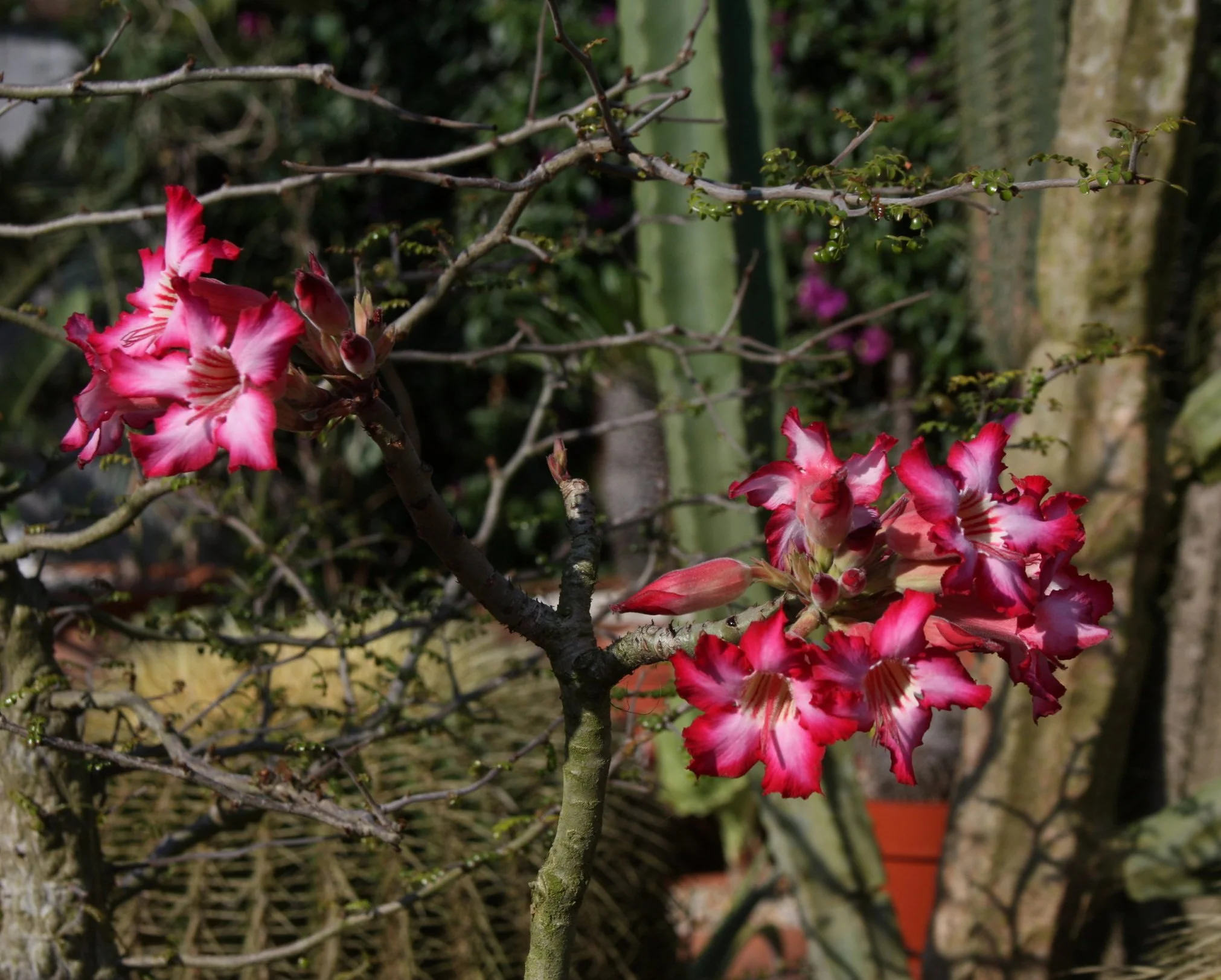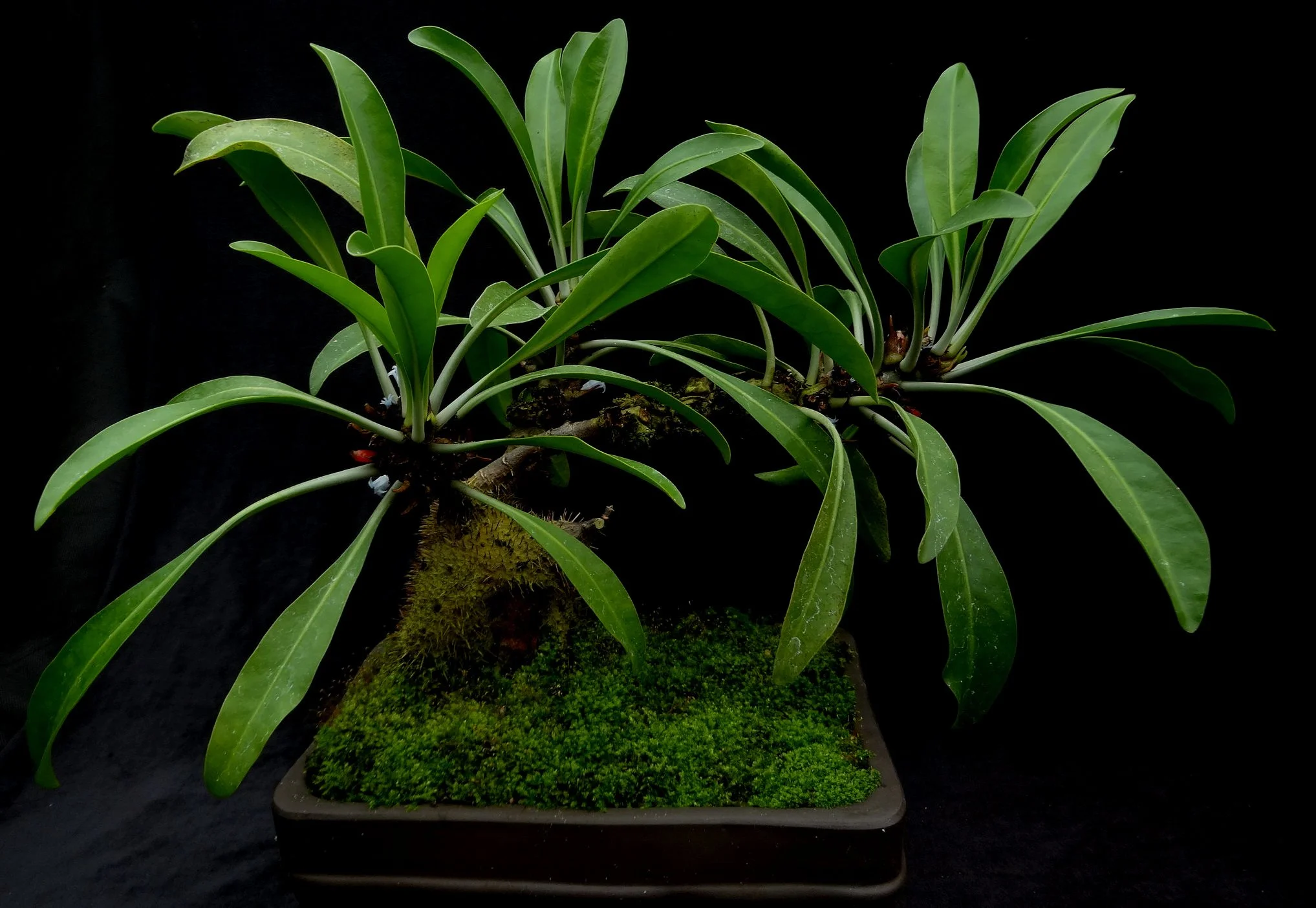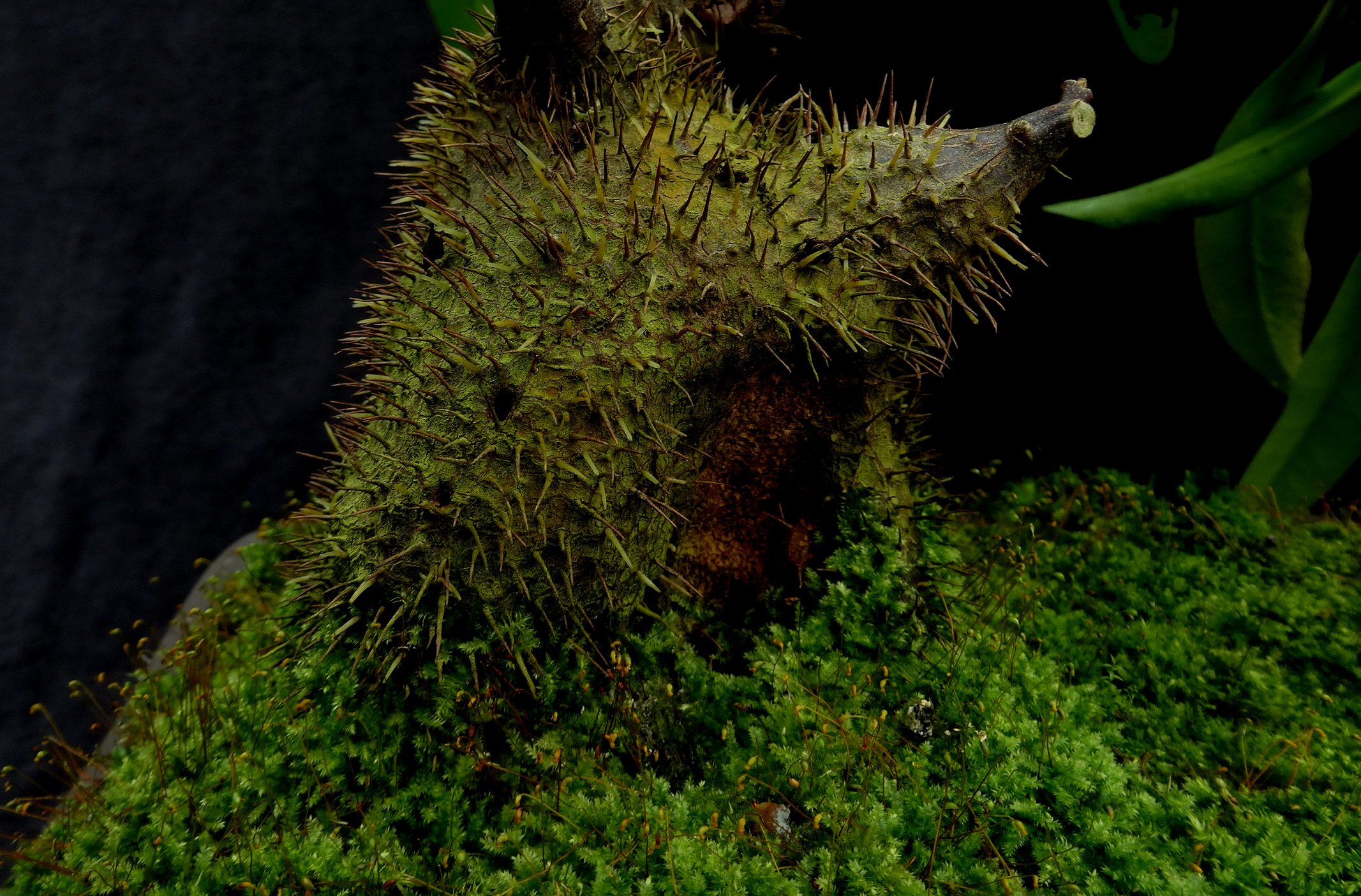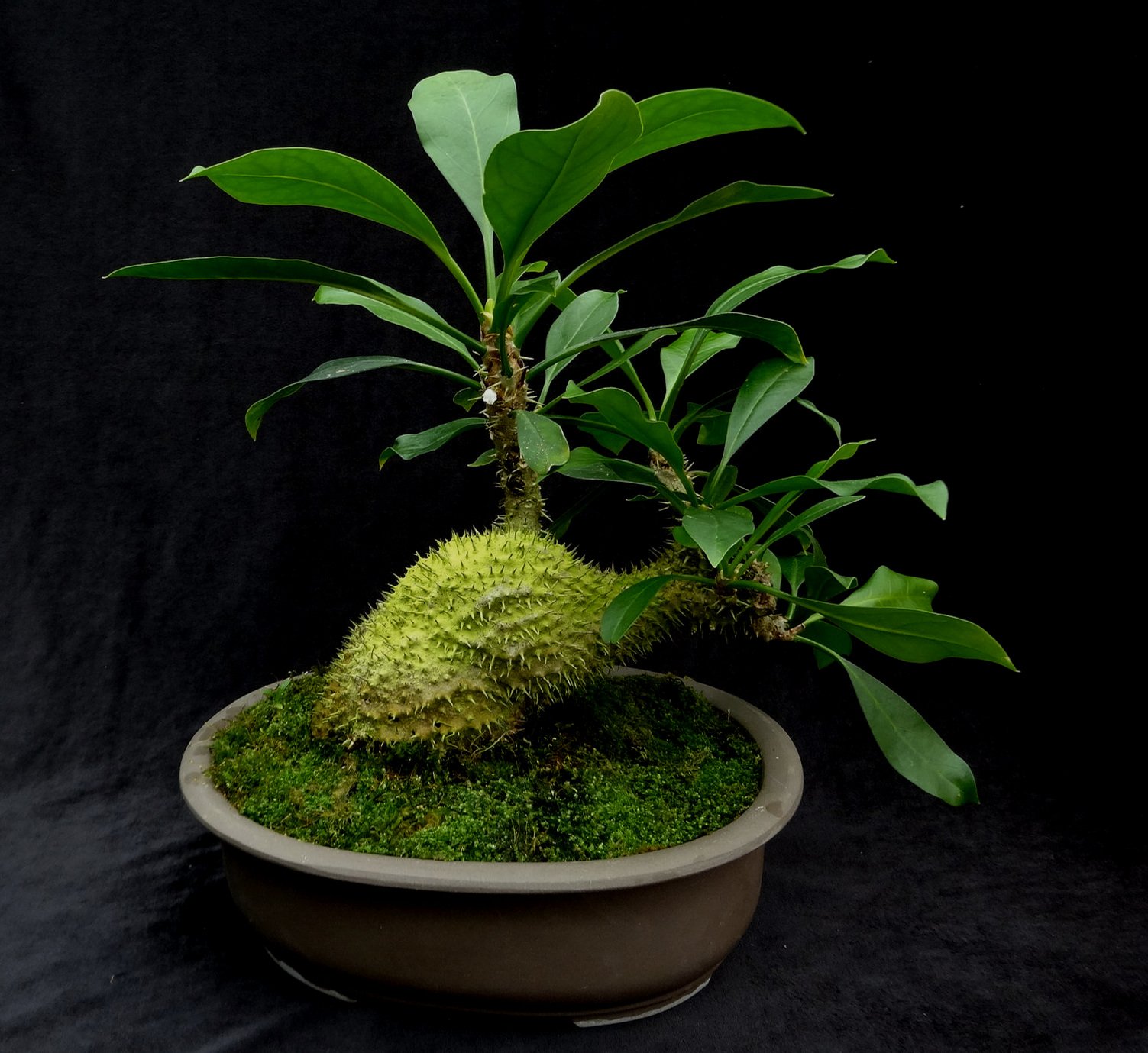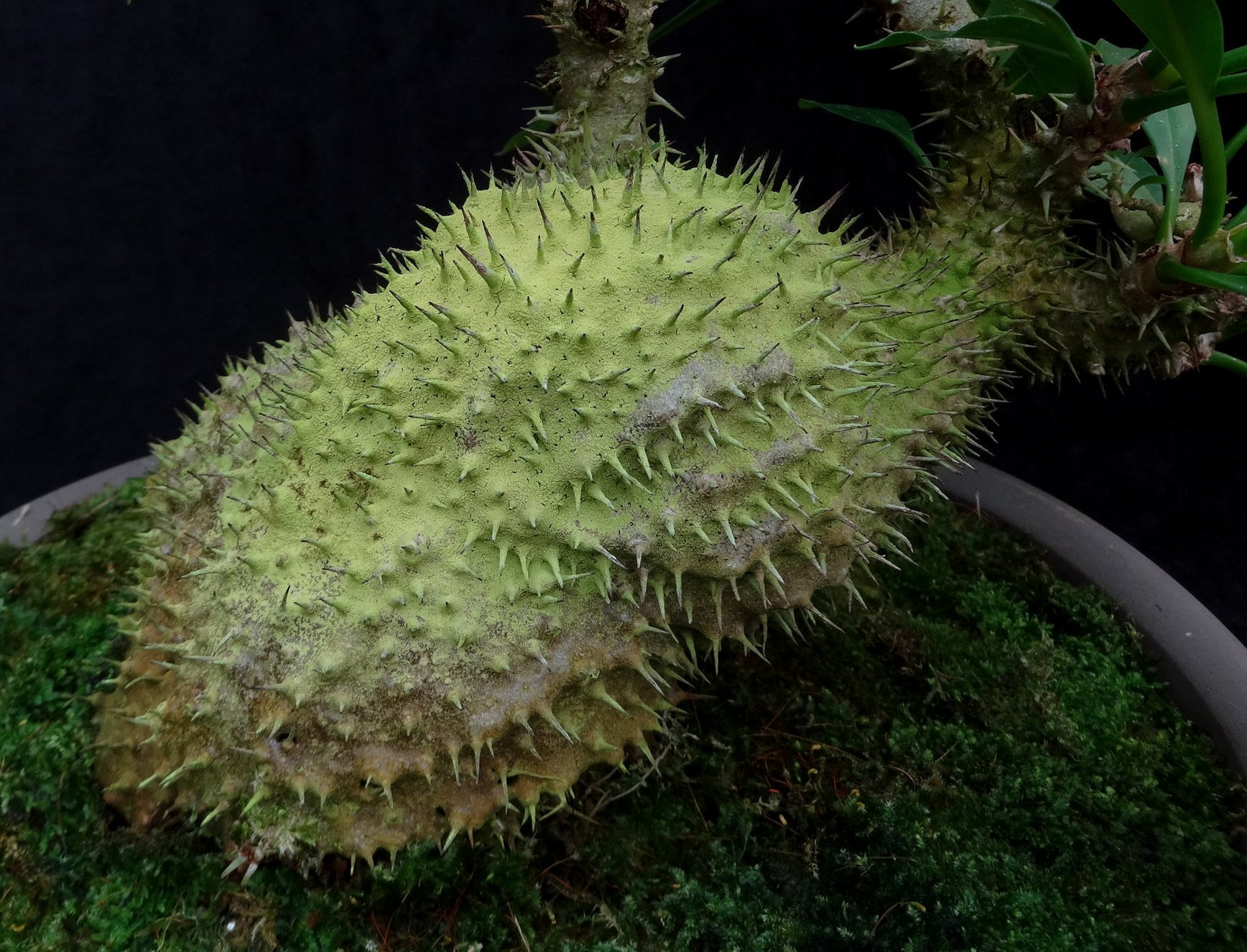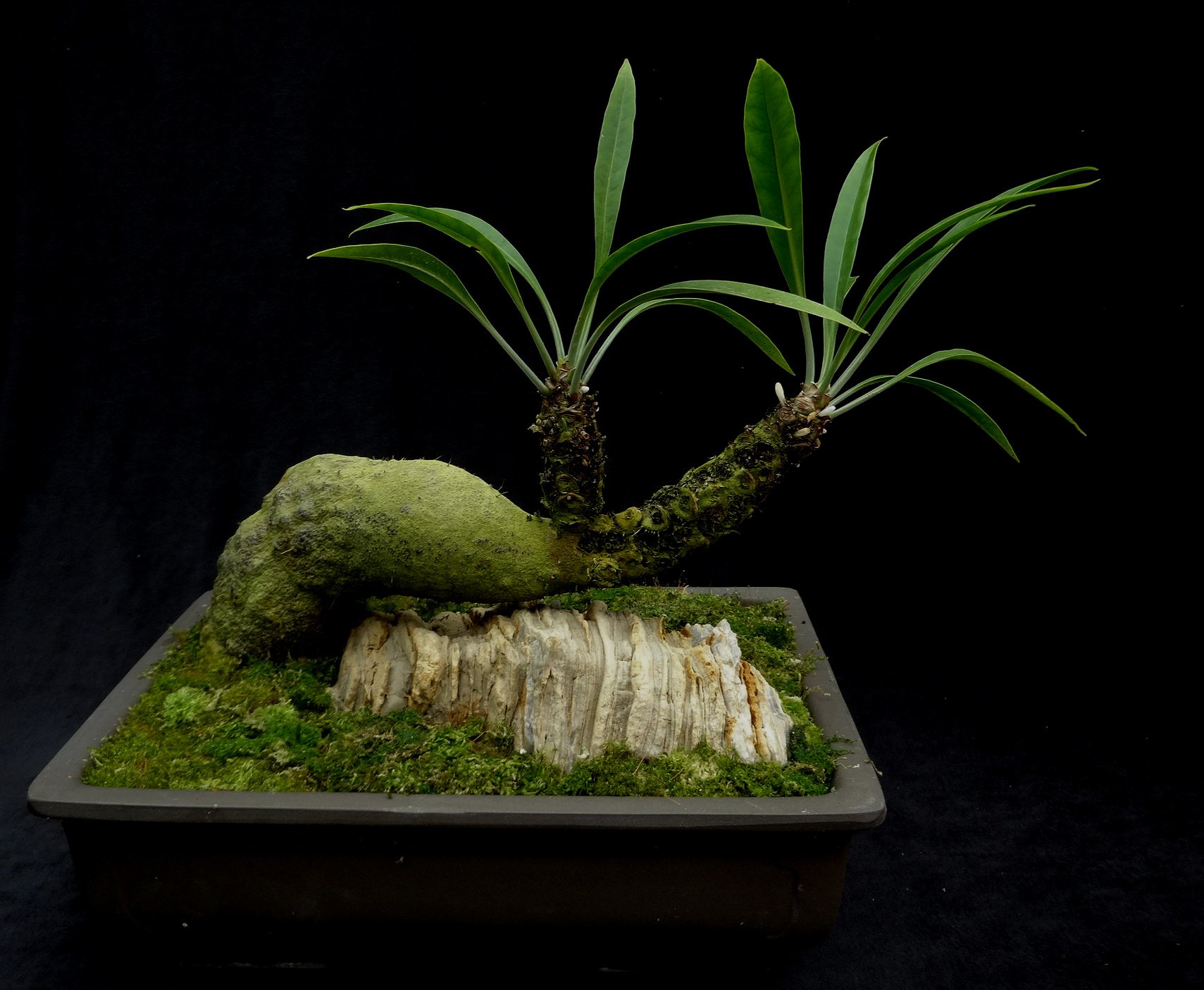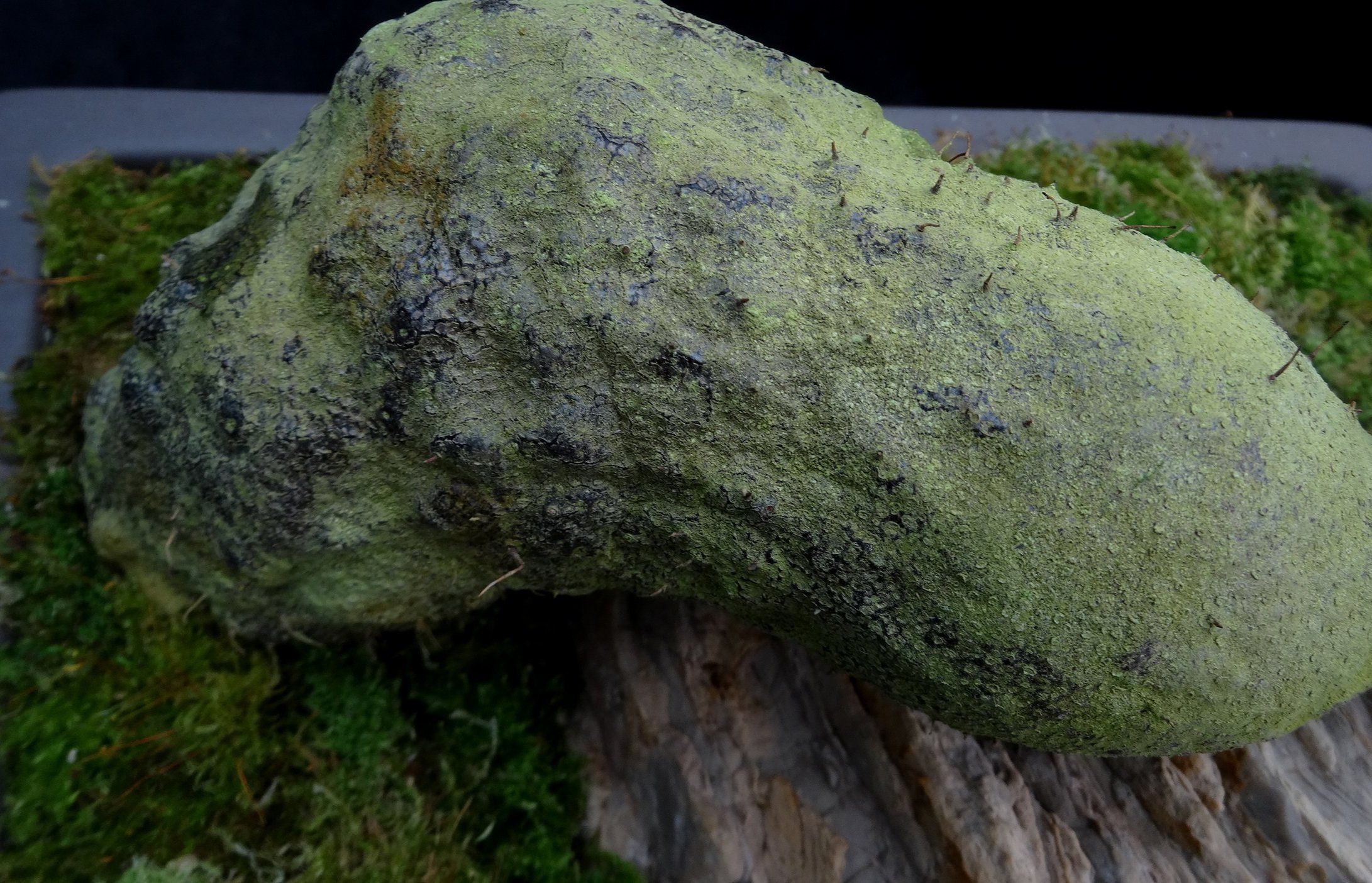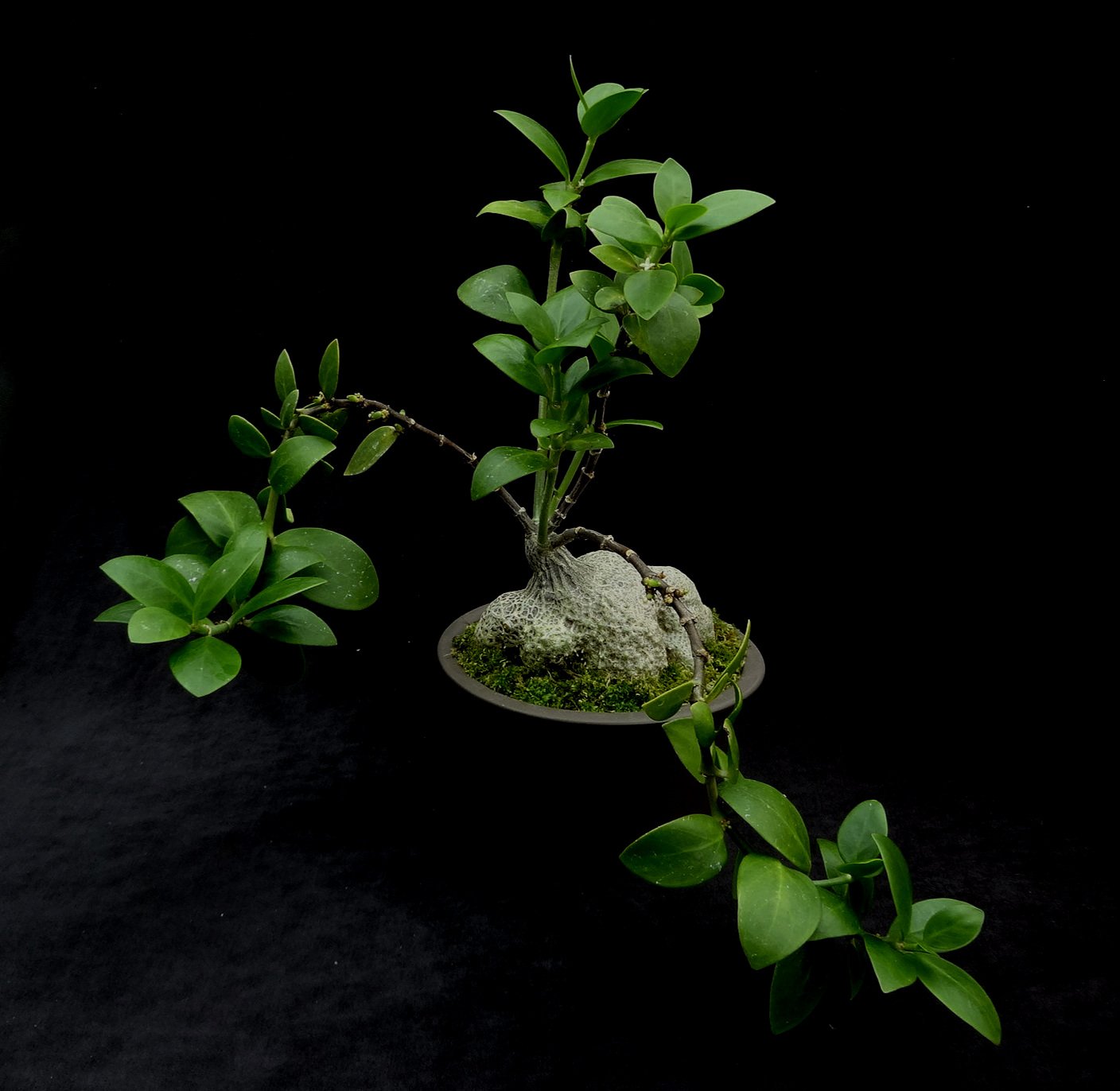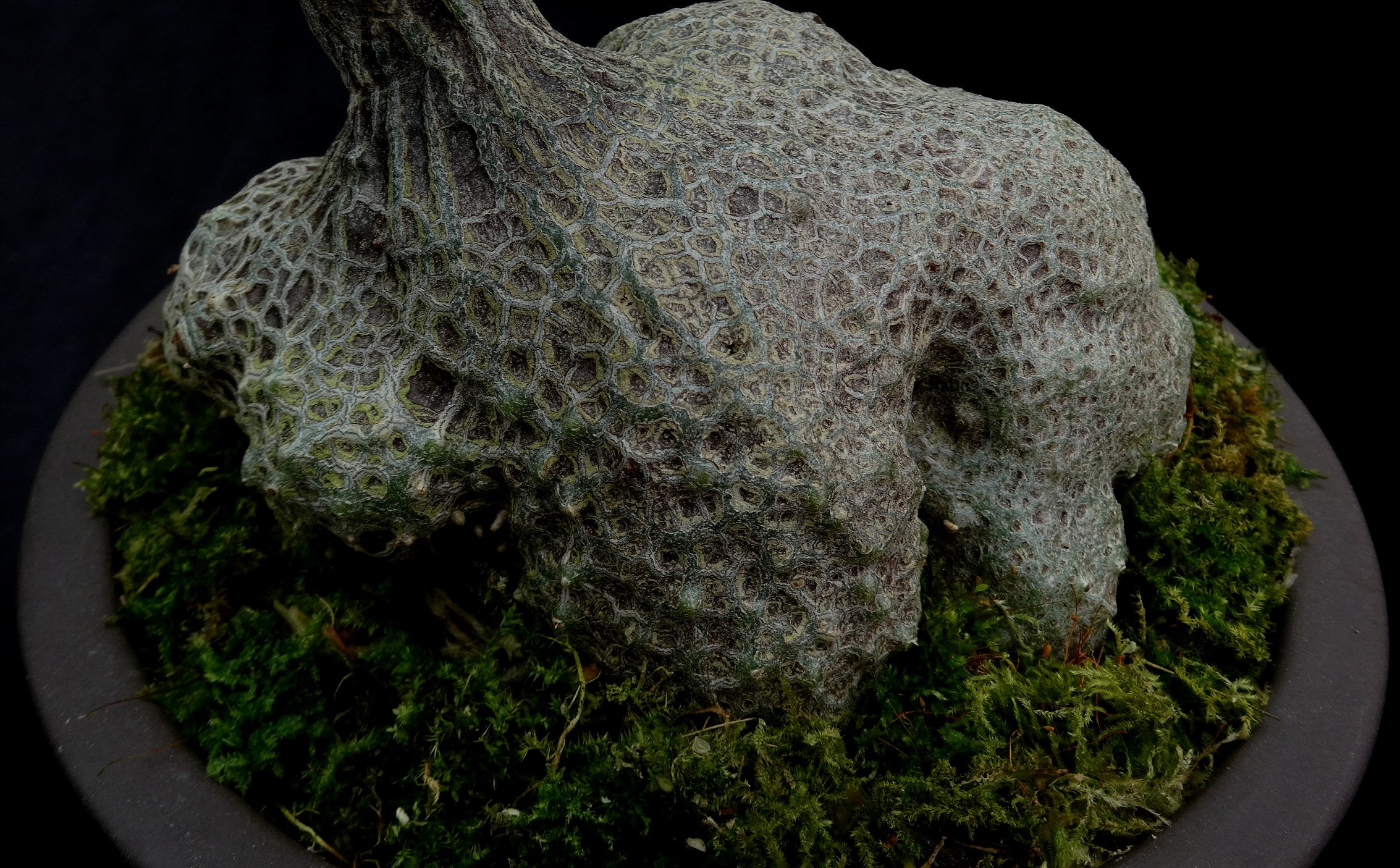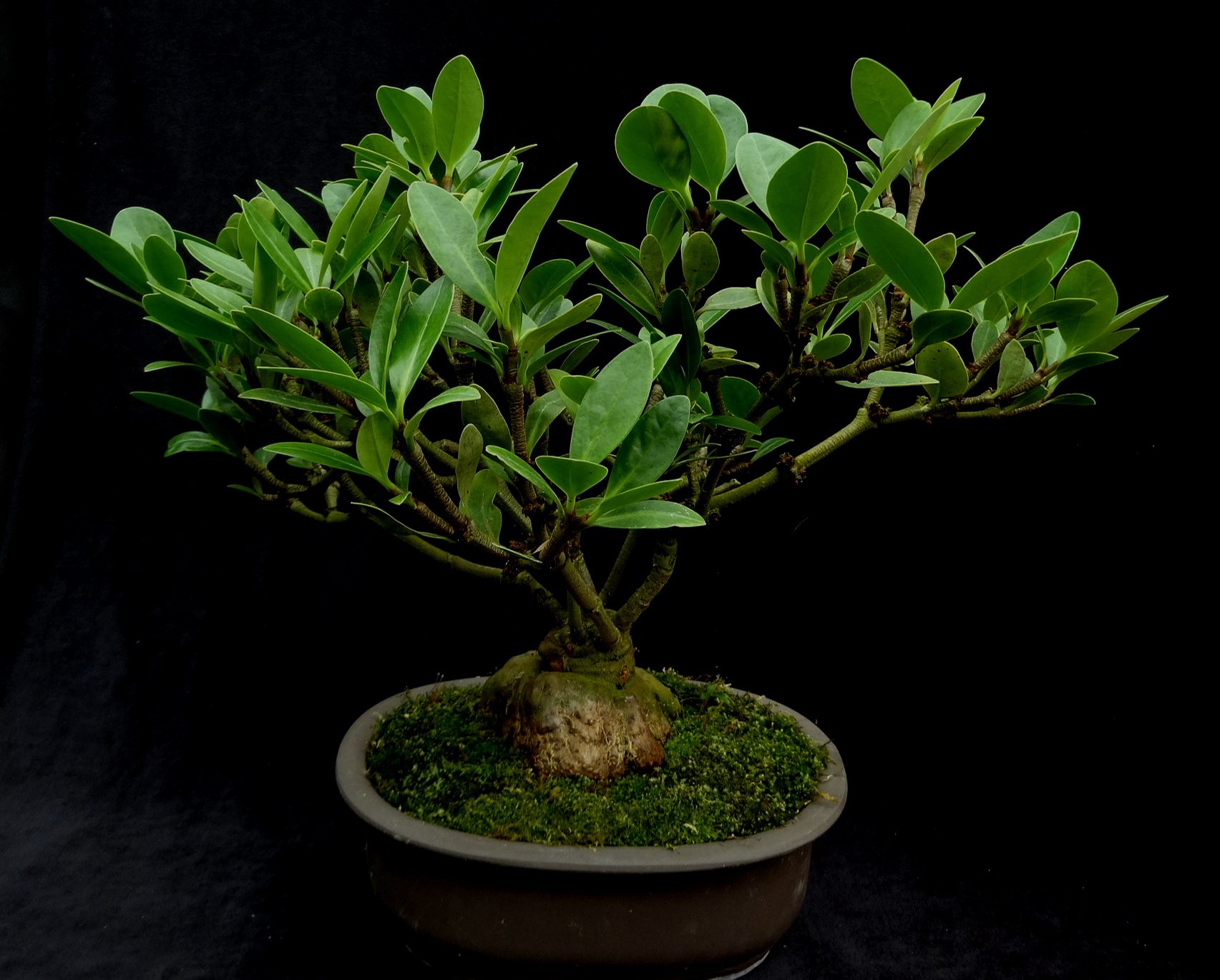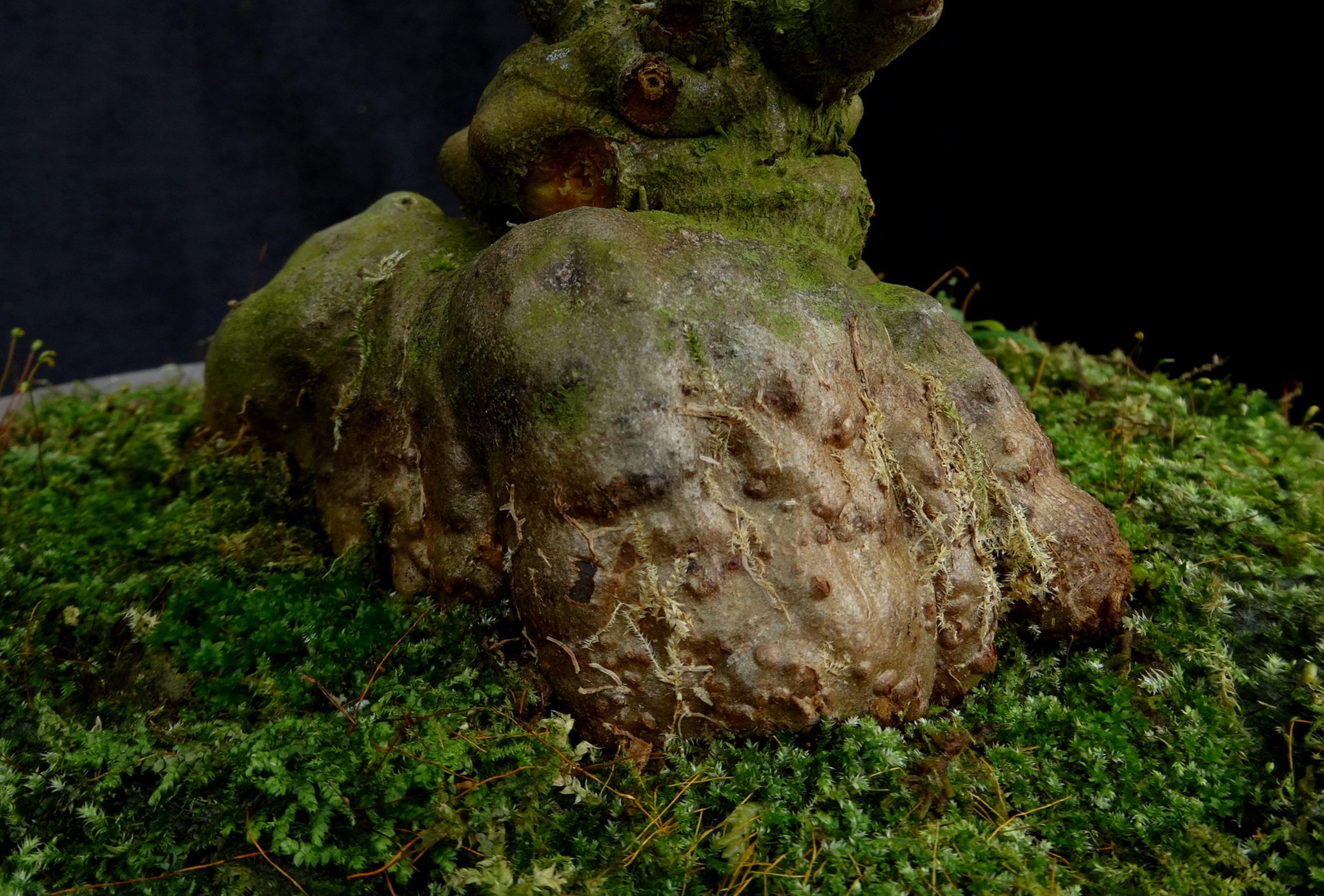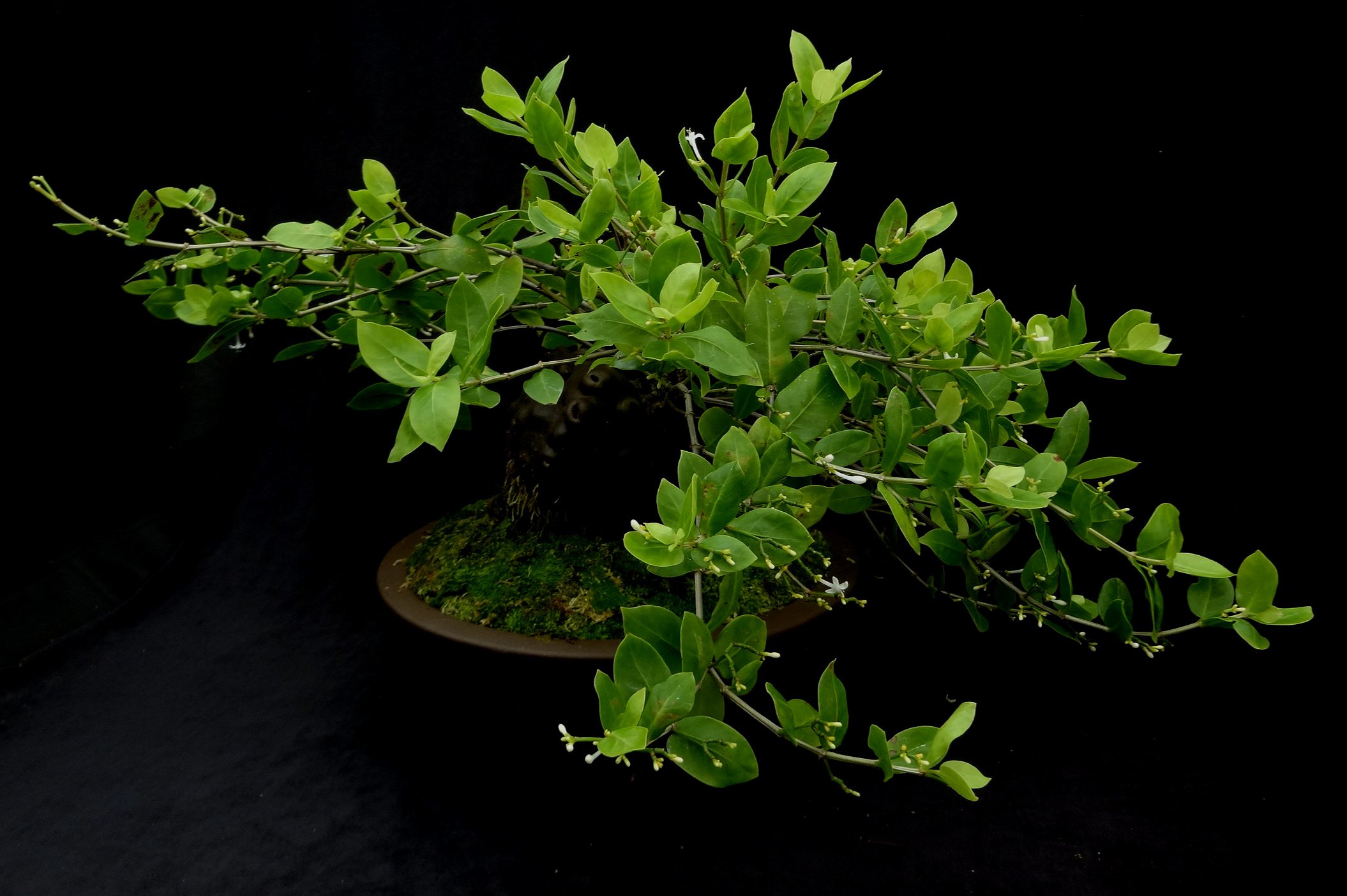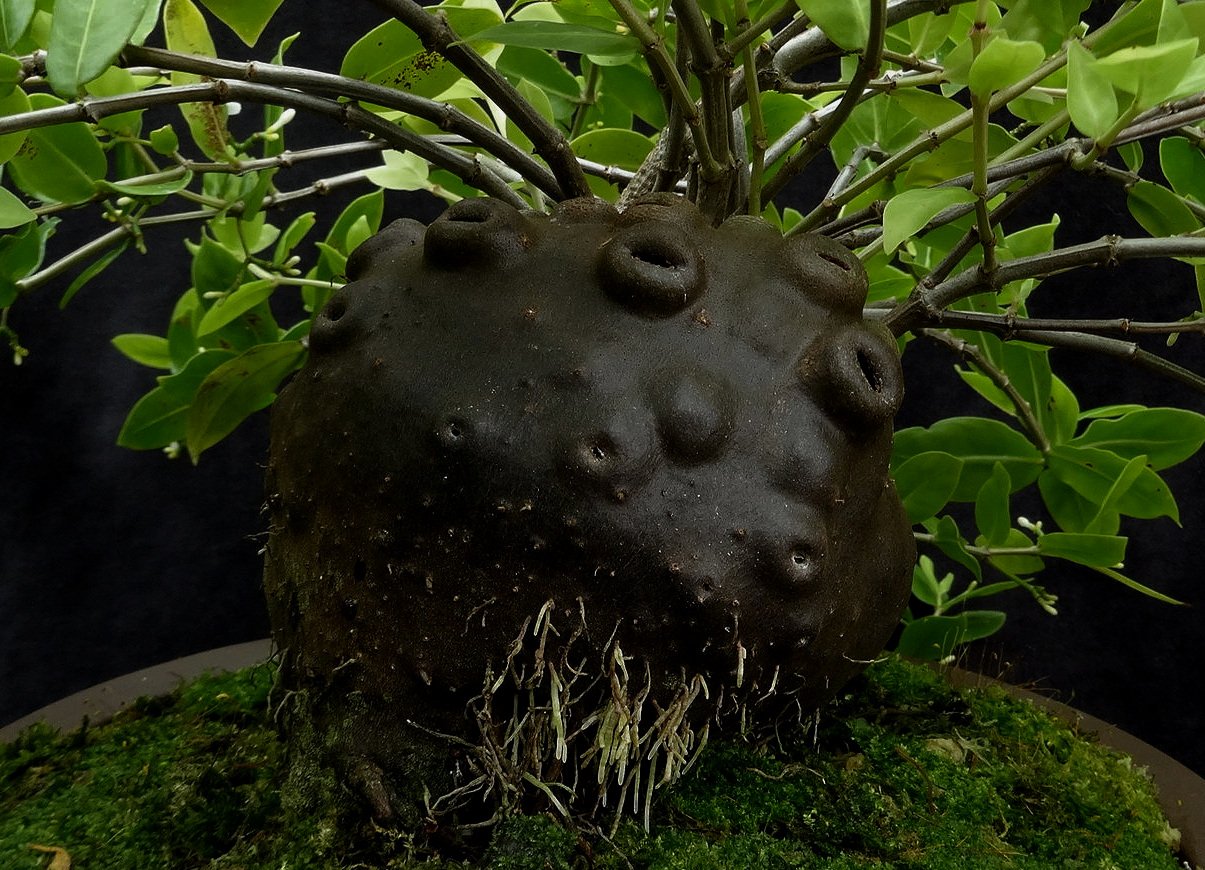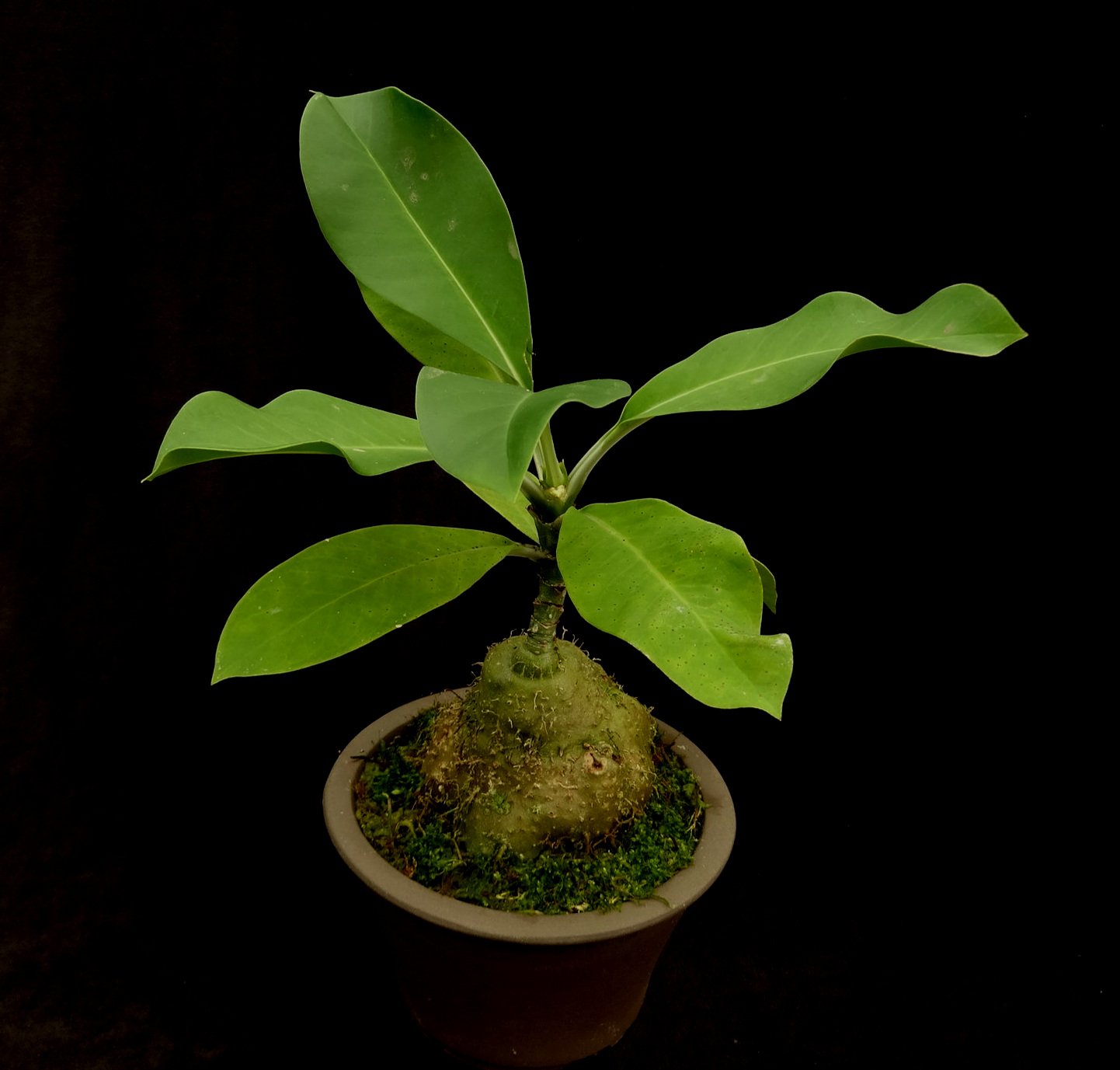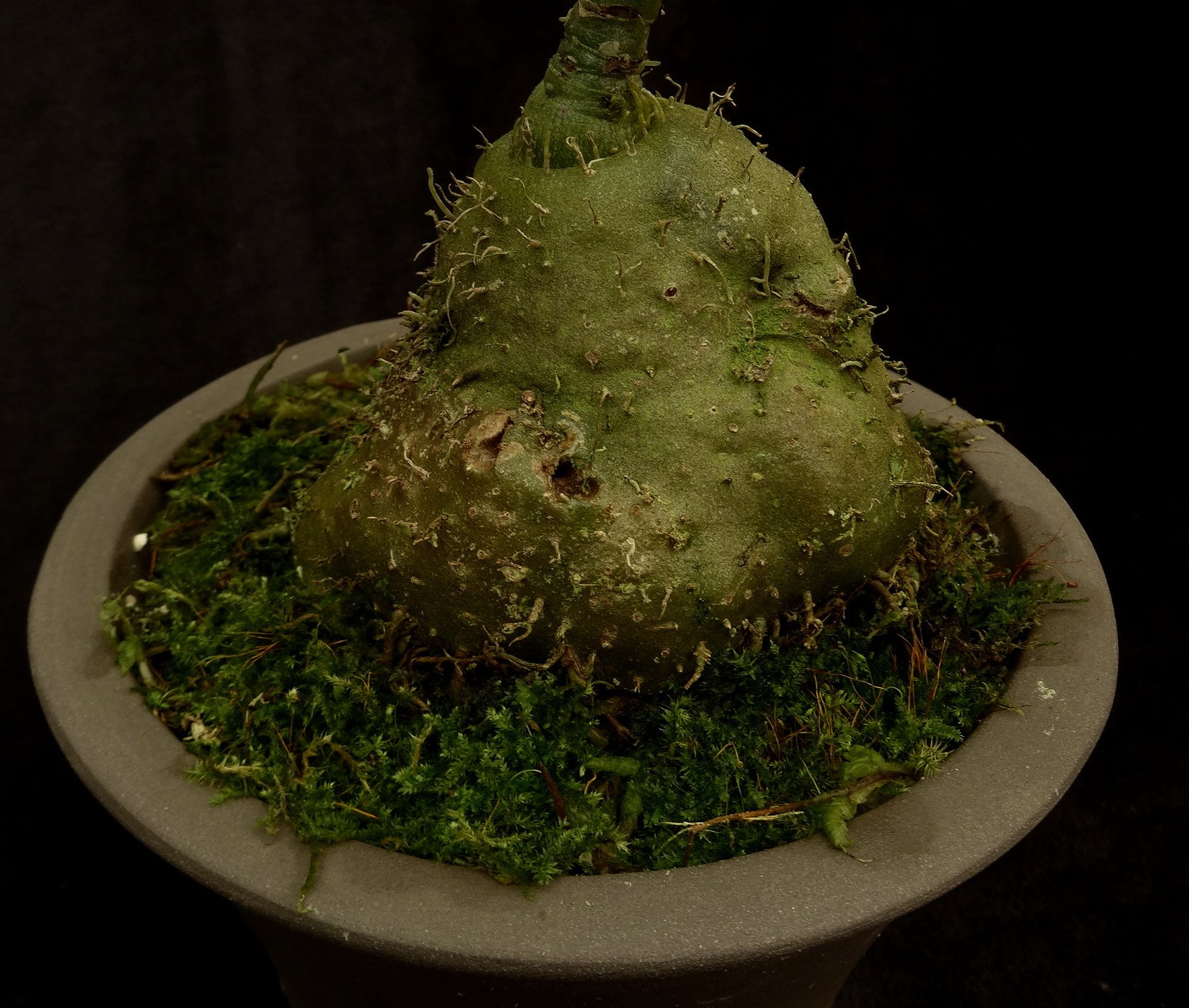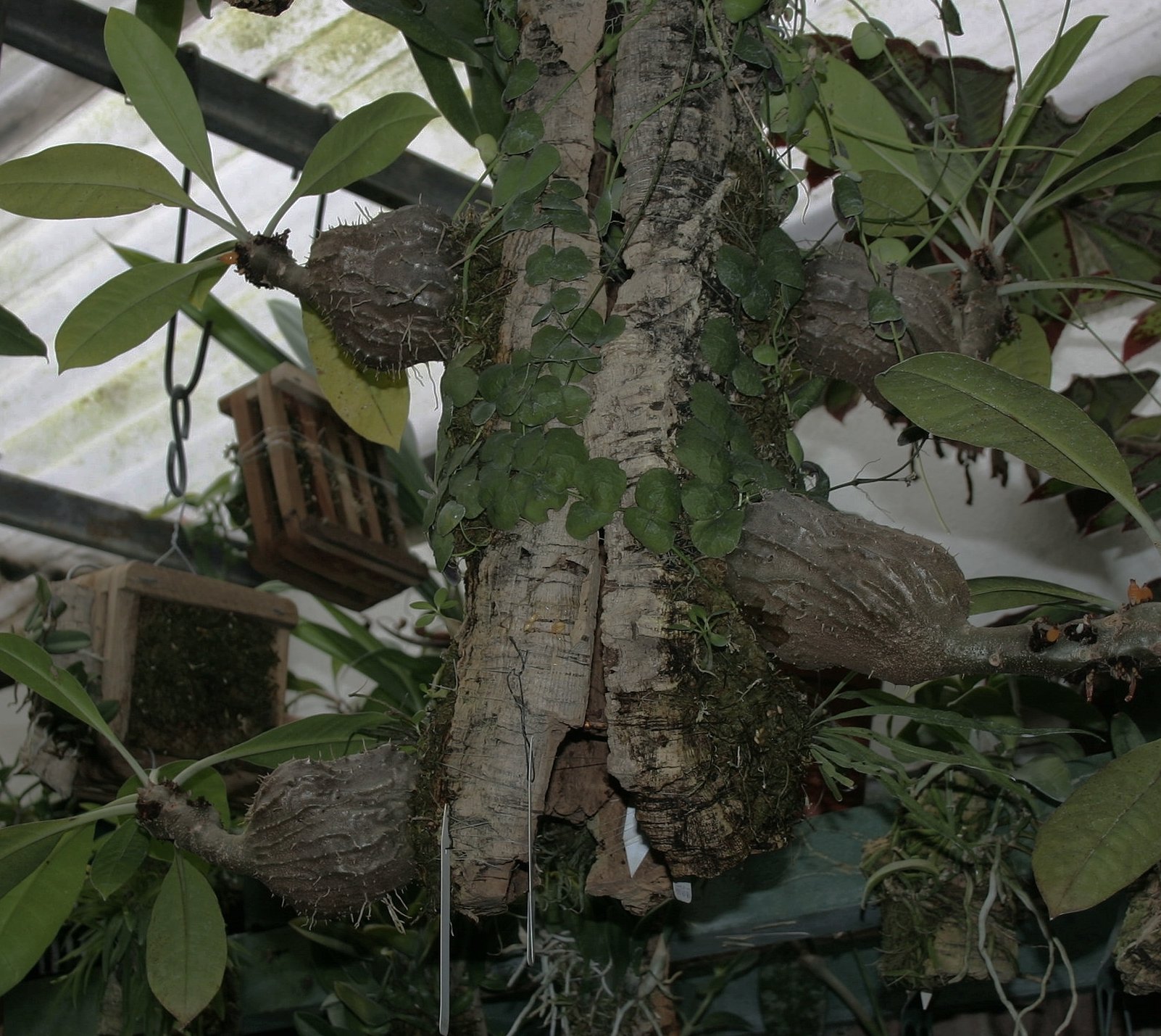Bonsai Ant Plants?
by Jay Vannini
Even ugly duckling caudexed ant plant seedlings of the common forms are useful to have around for educational purposes. Shown here a two year-old freshly-sectioned Myrmecodia beccarii of the intermediate form from Tully, Queensland, Australia staged in a 3.5” x 3.5”x 2.5”/9 cm x 9 cm x 6.5 cm unglazed Japanese Tokoname pot. This type of intentional injury for display early in life will be completely grown over in 24 months if the plant is treated with care.
The bonsai succulent movement–and the kitschy decorator trend that it inadvertently spawned–appears to have originated more or less simultaneously in England and southern California in the early 1980s. Images and publications from that period show that xeric plant growers in both countries who shared interests in classical bonsai and rare stem succulent cultivation saw obvious synergy in fusing these two gardening practices to display specimen-sized “fat plants”. Renowned British succulent enthusiast-author Gordon Rowley included some very good images of bonsai-staged caudexed succulents in his 1987 coffee table classic, “Caudiciform and Pachycaul Succulents”. Unfortunately, little cultural information on caudexed ant plants was provided by Rowley although he did mention hydnophytines as novelty greenhouse tropicals in passing. Despite its shortcomings, the real bible on this topic arrived a decade later in the guise of the second volume of Phillipe de Vosjoli’s “Pachyforms II: Bonsai Succulents” (2007), coauthored with Rudy Lime. While de Vosjoli does not show any bonsai-prepped hydnophytines in either of his books on fat plants, he did mention a few caudexed ant plant species as being especially worthwhile cultivating (e.g., Myrmecodia beccarii).
From my perspective and, despite its great value to caudexed succulent enthusiasts, the main weakness in de Vosjoli’s works are that they were published when only a handful of rather unremarkable hydnophytines were in cultivation. Twelve years ago, few growers outside of Tropiflora in Sarasota, Florida and the Atlanta Botanical Garden had succeeded in cultivating them long-term at all. Rather remarkably, of those species shown here, only three were in U.S. cultivation when “Bonsai Succulents” was published. While there are some very good examples of genuine bonsai-trained pachycaul (“fat plants”) and geophytic succulents shown in both of de Vosjoli’s books, by and large the pages show mostly lightly trimmed and elevated specimen collectors' plants, often of wild origin, staged in bonsai or custom pottery with added rocks and fancy gravel ground covers.
Several desert rose species - mostly Adenium arabicum “Jebel Shada” and A. sp. nov. ex-Tanzania - that have been lifted, pruned and trained for staging as bonsai succulents in the author’s Guatemalan collection in 2010.
Predictably, many classic bonsai purists have dismissed the contemporary “bonsai succulent” movement as nothing more than a vulgar misappropriation of their ancient and revered art form. As recently as 1984, de Vosjoli describes having his caudexed succulents being disqualified during setup at a San Diego Bonsai Society’s annual show for not being considered true bonsai. Unbowed, the following year, he and another local bonsai succulent grower went on to win blue ribbon for best bonsai exhibit at the Del Mar Fair with their pachycaul display. Unfortunately, this was a short-lived victory for both men since succulent plants were again excluded from bonsai judging at the Del Mar show the following year by still-intransigent local bonsai-wallahs.
A commercial quality unglazed Chinese ceramic bonsai tray repurposed to display a tabletop diorama of recently planted micro-miniature Malagasy aloes prepared as a gift for a friend. Clockwise from top center, a cluster of Aloe calcairophylla, A. boiteaui, a pair of A. droseroides and A. descoignsii. While three of these species are considered tricky in cultivation, this is otherwise a good example of “copy+paste” bonsai succulent presentation. Pot dimension 8” x 6.5” x 2.5”/20 cm x 16.5 cm x 6.5 cm. Author’s collection.
Rather ironically, there is increasing evidence that the widespread global popularity of bonsai succulents has influenced public tastes in bonsai proper over the past decade to favor shorter and much thicker trunks. In Asia, the U.S. and the EU, nurseries developing bonsai tree stock have responded by designing saplings that will then grow to conform to modern gardeners’ preference for the heftier “new look”.
My friend Luis Molina with a broad smile and a freshly dug, >10 year-old, seed-grown and bonsai-prepped Malagasy baobab (Adansonia za) from my collection in Guatemala.
Although I have trained or grown a number of tropical pachycaul trees in a semblance of traditional bonsai style, including almost all the Malagasy, African and Australian baobabs (Adansonia species), Malagasy Elephant trees (Operculicarya decaryi), shaving brush trees (Pseudobombax ellipticum) and the dwarf Mesoamerican Copal (Bursera schelechtendalii), I don’t really have a dog in this fight. In my view, bonsai purists do indeed have a valid point when it comes to their objections about labeling relatively fast-growing, succulent plants with gnarled shapes that are intended to evoke bonsai as “bonsai”. I certainly accept that the epiphytic ant plants shown here are best considered to be “bonsai-staged”, rather than examples of genuine bonsai. That said, it is obvious that the marriage of a timeless bonsai presentation and the bizarre forms of many older fat plants can produce some very visually compelling combinations.
Bonsai succulent growers, perhaps more so than classic bonsai practitioners, must strive to achieve the visual harmony that old-school bonsai artists emphasize when they admonish that, “One should not attempt to make a tree look bonsai, but rather make your bonsai look like a tree”. Clearly, as bonsai succulent growers we have rebelled against this traditionalist dogma but should always try and evoke at least the ghost of a tree.
As is also the case in some well-known tropical dogbanes like desert roses (Adenium species and hybrids) and pachypodiums (Pachypodium species), epiphytic ant plants lend themselves particularly well to being staged in bonsai pots and require a minimum of time, training and preparation to do so. Having looked at thousands of examples of both genera mentioned above in collections, nurseries and botanical gardens over the past 15 years, I’ve concluded that It is practically impossible to screw up the look of a desert rose plant or a southern wild grape (Cyphostemma species) & fancy pot combination - although – no doubt - it can be done by both novice and seasoned growers who are trying too hard…
Above left, a fancy color form of Adenium “obesum” displayed in a a lower end glazed bonsai pot, Desert Botanical Gardens, Phoenix, Arizona. Right, flowers on a 3’/92 cm tall example of the tree form of A. somalense var. somalense in my succulent collection in Guatemala. The latter species, together with A. arabicum, is exceptionally well-suited to display in bonsai style following extensive pruning and training.
Leaving aside my own experimentation with tropical tree and dogbane bonsai, German plant explorer, researcher and nurseryman Andreas Wistuba’s posted images of some of his stunted, older specimen hydnophytines shown on the excellent and well-illustrated Epiphytic Myrmecophytes Forum (please use this link to see: http://myrmecodia.invisionzone.com/topic/91-myrmephytum-spec-from-antimona-quezon-luzon-philippines/) were also an inspiration to display these plants outside of a traditional pot, wooden basket or hanging plaque setting. While Andreas appears to favor octagonal plastic, rather than rectangular or round ceramic pots, his hard culture, thoughtful plant positioning and use of live mosses as a ground cover combines in a very pleasing effect.
I admit being a bit of a stickler when employing Chinese (Yixing origin) and Japanese (Tokoname origin) bonsai pots for display. As a rule, I prefer to grow Asian, Malesian and Papuasian plants in them; simply put, the aesthetics and general vibe are just more pleasing to me. Other than that, unglazed purple and dark brown clay trays and pots seem to compliment with softer forest plant colors than with, say, the Tuscan terra cotta that accentuates the bolder lines of New World, African and Malagasy succulents exceptionally well. That aside, the very low profile a large sizes of Chinese bonsai trays makes them attractive platforms to work on when staging dioramas (see images of miniature Malagasy aloes shown above and the Pinguicula display elsewhere on this site).
Besides Chinese and Japanese pots, many U.S. specimen succulent growers commission custom ceramic pots from several well-known native artists to display their plants at regional and national C&S shows. A perusal of any of the better-known internet succulent fora will turn up some nicely-crafted and interesting-looking contemporary pots designed specifically for individual caudexed plants.
Well grown hydnophytines should have vigorous, if somewhat brittle, root systems. These will need to be trimmed when staging the plants in shallow bonsai pots. Shown, Myrmecodia platytyrea var. antoinii from Mossman Gorge, Queensland, Australia.
I have, for some time, been mulling a setup of all of the hydnophytine genera for a bonsai display this summer (2019) at the San Francisco “Orchids in the Park” exhibit in July to show visitors some of the amazing plants forms that have evolved in the subfamily. Fortunately, 18 months back I had asked a friend to do a beta test to stage in bonsai style a Myrmecodia tuberosa ssp. sibuyanensis that I gave him as a seedling about five years back, and his results showed considerable early promise. Hence the more ambitious experiments shown below, most of which have been staged in bonsai pot quite recently.
Like many caudexed dogbanes and southern wild grapes, hydnophytines can be surprisingly fast growing and will reward competent horticulturists with nice-sized stems and mature plant features in less than five years.
Besides lightening up their (hopefully) vigorous root systems a bit, transplanting larger epiphytic ant plants is quite straightforward, although some judicious branch pruning,and wiring may be needed to improve shape. In the recent past, I have topped several Myrmecodia platytyrea var. antoinii and a M. rumphii in an attempt to to improve their forms. I have found that a clean slice across the lower neck or “shoulders” of a medium sized fruiting plant will rapidly improve their looks by creating a much fuller canopy and a more globular caudex. Note: depending on how much stem is removed, desired results may take from 12 to 24 months to be evident. I have never lost a plant doing this, but admit it is not for the faint-hearted.I hope it’s obvious that rare species or irreplaceable specimen plants should not be chopped by anyone who does not have good growing conditions and a great deal of experience restoring wounded or rotted caudexed ant plants to health.
Above left, a 30 month-old seed-grown Myrmecodia platytyrea var. antoinii freshly repotted in a plastic basket, with red line indicating where a cut should be made in order to improve future plant form. Right, a four year-old M. rumphii from Ambon one year after having been topped to fatten the caudex and change canopy shape. Note the multiple stems developing around the upper edge of the caudex which will give the plant a more pleasing, balanced aspect in another year or so.
A very aggressively topped young Myrmecodia platytyrea var. antoinii that will hopefully have a fully globular caudex with multiple stems in about two years. The visible internal cavities will have fully scarred over within a year or so. Plants should be dusted with a broad spectrum contact fungicide and charcoal, kept bright and well-ventilated, and (dare I say, “obviously”?) watered with great care for several months following this type of trauma.
Below, I have included photos of all of the currently recognized hydnophytine genera (five) staged in hand thrown, unglazed Yixing and Tokoname clay pots of various styles and color shades. All plants shown here are being grown in New Zealand long fiber sphagnum moss, topped with a couple of non-invasive terrestrial native mosses as ground cover. I have also used small slips of the pH neutral so-called “pagoda stone” as accents where I thought appropriate.
Commercially available high-end Yixing clay bonsai pots have plenty of drainage and do not require any further work with a masonry drill. When using sphagnum, I don’t bother covering the larger holes with plastic mesh since it is unnecessary.
One drawback to working with these finer handmade eastern Chinese and Japanese bonsai pots is that they commonly range from USD 50.00 to USD 150.00 each for smaller pots depending on size and finish, with higher quality examples running into the several hundreds of dollars for even quite small pots. The use of commercial quality pots for staging and growing out provides an excellent starting point for hardcore collectors who may ultimately wish to invest in high end (i.e. those running into four figures) pots down the road.
Pssst – even though they’re relatively heavy and are apparently robust, expensive ceramic bonsai pots will break when mishandled.
Besides showcasing leaf-perfect specimen plants, partially disfigured hydnophytines that have suffered extensive caudex or stem rot are particularly suitable for growing on in this style to highlight their twisted forms after they have scarred over larger wounds.
Speaking of which, here is a quick hack for dealing with stem rot, intentional wounding to create character, or even more aggressive pruning to distort forms or cross-section hydnophytine caudexes. I mix equal parts of powdered Captan (check local availability and use restrictions) and powdered activated charcoal and liberally dust all wounding surfaces after a thorough syringing with hydrogen peroxide at 3% concentration. Leave the plant unpotted in a shady, well-ventilated area for a few days to ascertain that the rot has stopped, and that wounded tissue has begun to dry.
Gallery:
Plant dimensions were taken across the widest point in the canopy x lowest to tallest point on the specimen. Pot dimensions are shown as length x width x height; shape is evident in the photos. In this selection I have used round, oval, and rectangular forms. Both trays and so-called “cascade” pots have been used. Age given is in number of years from seed sow. All plants shown have been seed-grown by the author – almost entirely from artificially-propagated second or third generation seed - and greenhoused in San Francisco, California. Origin indicate the provenance locality of founders.
Myrmephytum cf. beccarii
Origin: Quezon Province, Philippines
Age: six
Plant dimensions: 18” x 14”/45 cm x 35 cm
Pot dimensions: 10” x 8” x 3”/25 cm x 20 cm x 7.5 cm
Notes: This plant entered cultivation in the mid-2000s from Merlin Sy’s Pinoy Plants seed exports. There is some doubt as to whether this is really M. beccarii (fruit color differs somewhat from the original description) or a very closely related, presumably undescribed Philippine Myrmephytum species. While apparently few of the original imported or seed-grown plants survive (perhaps in the EU and Asia), I have now cultivated large numbers of this taxon into third generation and, coupled with Andreas Wistuba’s distributions, it is now very well-established in cultivation around the world. Slow growing, but not fussy. The vivid light blue flowers and ruby red fruits make this brown-caudexed, bristle-spined species especially attractive to collectors.
Myrmecodia papuana
Origin: Cape York Peninsula, Queensland, Australia
Age: seven
Plant dimensions: 12” x 10”/30 cm x 25 cm
Pot dimensions: 10” x 8” x 3.5”/25 cm x 20 cm x 9 cm
A large, impressive and easy to grow hydnophytine that ranges from the lowlands of the southeastern Papua New Guinea mainland and off islands to the Cape York Peninsula of northern Queensland, Australia. Take care when handling larger plants; the root spines are not for show! Outside of Australian collections, few plants appear to have definite locality data associated with them, but most are presumed to have originated from older legal accessions from Kutini-Payamu made by Australian botanists that subsequently made their way to collections in Singapore and the EU early during the past decade, then on to the U.S. This species sometimes trades as M. sp. “pink fruit” or as a variety of M. tuberosa. The coral pink or bright red fruit are very distinctive. Younger seed-grown plants that I grow from Normanby Island, Milne Bay Province, Papua New Guinea are visually identical to Cape York plants. This is a deservedly popular species in cultivation that is, unsurprisingly, rather cold sensitive but can usually be rescued from localized caudex rots caused by excessively low temperatures.
Myrmecodia platytyrea var. antoinii
Origin: Mossman Gorge, Queensland, Australia
Age: 10
Plant dimensions: 24” x 16”/60 cm x 40 cm
Pot dimensions: 12” x 10” x 3.5”/30 cm x 25 cm x 9 cm
Another very popular northeastern Australian hydnophytine species with succulent leaves that does well in captivity and is particularly suited to having its form modified by aggresive pruning or removal of top growth. As is the case with M. papuana, the root spines on this species are very sharp and the tips readily break off just under the skin when handled incautiously. The Mossman Gorge var. antoinii differ in appearance from both the ecotype that occurs in Kutimi-Payamu region further to the north, as well as plants originating from Milne Bay Province, Papua New Guinea. Limited cold tolerance (tolerates brief periods near 50 F/10 C if kept dry and well-ventilated) but will often defoliate or rot branches when unhappy with its environment.
Myrmecodia sp. “Bali Nursery”
Origin: commercial orchid nursery, rural Bali, Indonesia
Age: seven
Plant dimensions: 15” x 9”/43 x 23 cm
Pot dimensions: 11” x 8” x 3.5”/28 x 20 x 9 cm
Notes: This enigmatic and rather unique species shares some traits with the New Guinea endemic, M. longissima. Despite the superficial resemblance, it is probably an undescribed species native to West Papua that was purchased at a highland orchid nursery on Bali by an acquaintance in Singapore. After growing it successfully at his home, he subsequently distributed seed to a few collectors in the EU and the ‘States. The large, barrel-like, almost spineless caudex coupled with very narrow leaves makes it a superb collectors plant. It can be trained to grow either straight upright or pendent. This species has proven to be hardy across a wide range of temperature regimens from cool to very warm, as is often the case with Indonesian Papuan hydnophytines. I chose to incorporate pagoda stone in this bonsai staging to emphasize that several West Papuan myrmecodias are known to occur as coastal lithophytes as well as epiphytically.
Hydnoptum moseleyanum “Black Caudex”
Origin: Unknown, possibly an insular Indonesian of Papua New Guinea form of the species
Age: seven
Plant dimensions: 10” x 18”/25 cm x 45 cm
Pot dimensions: 9” x 3”/18 cm x 7.5 cm
Notes: As currently defined (Jebb and Huxley 2019), this is a very wide-ranging species from coastal forests in the Philippines, the lowlands of Maluku Island and much of the island of New Guinea as well as mangrove ecosystems on the Solomon Islands (see below). There are many far nicer looking ecotypes of H. moseleyanum than this one in cultivation, that originated at UC Davis’ conservatory, but the stable dark caudex color and narrow, upright habit of this form is noteworthy. See the ecotype below for similar caudex texture in an insular population from the eastern extreme of the species’ range. In this particular case, the interesting cavity that localized caudex rot left on this young plant made it a good candidate for salvage and display.
Hydnophytum moseleyanum “longistylum” form
Origin: Topinang, Bougainville Island, Papua New Guinea
Age: five
Plant dimensions: 17” x 10”/43 x 25 cm
Pot dimensions: 6.5 x 4”/17 cm x 10 cm
As was expected, Jebb and Huxley recently sunk H. longistylum into H. moseleyanum along with all the other insular forms from this group, some of which (esp. some Philippine populations) seem quite distinct in life. I have a fair number of documented, seed-grown living material of H. moseleyanum (formerly H. papuanum) from both the eastern coast (Lae, Morobe Province) and the Louisiade Archipelago (Orangerie Bay, Milne Bay Province) of Papua New Guinea as well as the Kutini-Payamu in northeastern Queensland, Australia and they are visually distinct from this plant in a number of ways. Naming controversy aside, this ecotype is restricted to coastal forests in the Solomon Islands to about 975’/300 m. First introduced to western collections in 2014, it remains very rare in cultivation. Its highly succulent roots may form galls and leafy outgrowths with time. Caudexes are usually very flat, gray or brown in color, have a distinct “neck” and sometimes resemble amorphous melted metal growing in nature or when mounted on cork plaques. Based on my experience with dozens of both wild seed origin and F1 seed-grown plants, it is much, MUCH slower growing than H. moseleyanum forms from northeastern Malesia, mainland New Guinea and northern Queensland, Australia.
Hydnophytum ferrugineum
Origin: McIlwraith Range, Queensland, Australia
Age: eight
Plant dimensions: 18” x 12”/45 cm x 30 cm
Pot dimensions: 9” x 7” x 3.5”/23 cm x 18 cm x 9 cm
A very slow growing Queensland, Australian endemic that narrowly escaped being sunk into varietal status of the wide-ranging H. petiolatum by Jebb and Huxley in their recent review of the genus. A rainforest canopy plant in nature, it is an excellent addition to any tropical epiphytic succulent collection. There have been recent legal, monitored accessions from new localities in northeastern Queensland that augment the very narrow original genetics and that lack the characteristic brown striping on the otherwise bright orange globular fruit that is associated with early introductions. This species develops a large number of small, round entrance holes on its caudex upon maturity but it takes many years in cultivation before they become evident. Easy and temperature tolerant but rather prone to mealybug infestations.
Hydnophytum radicans “simplex” form
Origin: Aru Islands, Maluku Province, West Papua, Indonesia
Age: five
Plant dimensions: 16” x 11”/40 cm x 23 cm
Pot dimensions: 8” x 2.5”/20 cm x 7 cm
Another species sunk into synonymy in the recent revision of the genus Hydnophytum by Jebb and Huxley. Hydnophytum radicans is now considered to be a wide-ranging species that occurs from coastal to cloud forest on Maluku, Indonesian Papua and southern Papua New Guinea to as far east as Normanby Island in Milne Bay Province. This particular plant (formerly known as H. simplex) was the first form of H. radicans in cultivation and originates from a living collection from Aru cultivated at Leiden. More recent accessions from southeastern Papua New Guinea, as well as some highland populations vary with regard to stem, caudex and leaf shapes, floral characters as well as fruit color and morphology. This species is easy to grow but requires frequent pruning to keep from becoming leggy. Easy, but like many insular hydnophytines, it despises cold and will produce floppy, incurved or otherwise distorted leaves when maladapted. This one has recently been topped of its main canopy to reduce apical dominance, hence the plant’s rather sparse aspect.
Squamellaria kajewskii ‘Alien Octopussy’
Origin: Panguna, Crown Prince Range, Bougainville Island, Papua New Guinea
Age: three
Plant dimensions: 24” x 12”/60 cm x 30 cm
Pot dimensions: 10” x 4”/25 cm x 10 cm
An astounding and deservedly celebrated hydnophytine ant plant, and one with one of the most interesting caudexes in the entire subtribe. Formerly known as Hydnophytum kajewskii. A rare and choice collectors plant, it is usually easy and fast-growing in cultivation but sometimes prone to suddenly defoliating for no apparent reason. Fortunately, they will re-leaf after a couple months, but the experience can be understandably unnerving the first time it occurs to your plants. Very susceptible to spider mite infestations when kept too dry. More than any other hydnophytine species that I have experience with, this species requires careful pruning to keep the inner canopy from becoming too dense. Introduced to cultivation in 2014, this remarkable and fast-growing species has now been bred to F2 in the U.S. by me. Despite its fame for having scaphoid or “boat-shaped” caudexes, most individuals that I have grown (n= ~80) have squat, globular bases, and Derrick Rowe has also published images of gigantic, globular caudexes in this species growing in the wild. However, the octopus’/extraterrestrial-looking eyes, or porthole type entrance holes on the upper edges of the caudex are an attractive constant. Squamellaria kajewskii, while technically tristylous is functionally dioecious, so both pin and thrum flower forms are required to set viable fruit. This is a particularly good F1 longistylous/”male” clone developing a scaphoid caudex shape and very bulbous apertures on its upper caudex early in life.
Squamellaria imberbis
Origin: Vanua Levu, Fiji
Age: three
Plant dimensions: 12” x 15”/30 x 43 cm
Pot dimensions: 5.5 x 5.5 x 9”/14 cm x 14 cm x 23 cm
A very recent introduction from seed obtained by Andreas Wistuba, it was fortuitously reproduced to F1 at an early age by Frank Omilian in the U.S., so now is available in limited numbers as domestic seed-grown plants. Can be self-fertile and reasonably fast-growing when kept warm and humid. This handsome epiphytic species has very dark-colored, football-sized caudexes when mature. The Fijian squamellarias are remarkable for the random placement of their long, leafy stems and near globular caudexes, often with constrictions along their length. They are all eminently suited to display in tall, cascade-type bonsai pots that allow their branches to hang down well below their caudexes. While still costly and somewhat difficult to find for sale, all are worth growing.
Anthorrhiza bracteosa
Origin: Sibonai, Normanby Island, Milne Bay Province, Papua New Guinea
Age: two+
Plant dimensions: 10” x 8”/25 cm x 20 cm
Pot dimensions: 3” x 3”/7.5 cm x 7.5 cm
The last hydnophytine genus to enter broad cultivation, all of the horticulturally desirable Anthorrhiza species are now being grown in rare plant collections in the EU, Asia and the U.S. The genus is endemic to the eastern half of Papua New Guinea with both lowland insular and high elevation adapted taxa. Several are very large and heavy plants when mature. This particular species is restricted to low and middle elevation rainforests on the D’Entrecasteaux Islands in the southeastern part of that country. Both Frank Omilian and I have recently produced F1 seedlings of this species on young plants in the U.S. An added attraction are the subvelvety leaves that are almost unique among hydnophytines. For such a rare and unusual-looking plant it is quite trouble-free in cultivation. Indeed, this oddity may be one of the most tractable and precocious species of hydnophytines that I have ever grown.
Apart from the species shown here, several other hydnophytines are exceptionally good candidates for presentation in bonsai pots. Notable among these are the now near-ubiqitous Hydnophytum puffii, the exquisite giant rarity, Squamellaria guppyana, and the commonly cultivated Myrmecodia tuberosa form originally from Bako NP in Sarawak. Once they inevitably enter (wider) cultivation, the fantastic Myrmephytum arfakianum and Hydnophytum caminiferum, both of which are localized endemics to the higher elevation stunted forests of West Papua, Indonesia, would also look spectacular staged in the right high-end bonsai pot.
Many of these epiphytic ant plant species are suitable for cultivation in a warm, bright bay window or on a terrace or patio table during warmer months. Most are also suitable for normal hanging basket cultivation in warm tropical gardens. While they do require high light levels to bulk up, always avoid exposure to direct midday and afternoon sunshine. Despite their succulent lifestyle, their growing media should not be allowed to dry out completely between waterings.
Keep a watchful eye out for mealybugs, aphids and spider mites, drench lightly with a balanced fertilizer every 10-15 days at orchid strength and, “Voila!”
No cheesy ceramic figures as accents, please.
Acknowledgements
A special thanks again to Frank Omilian, Andreas Wistuba and Derrick Rowe for their tireless efforts to promote interest in caudexed ant plants, for supporting regional ecotourism guides and seed sources in addition to successfully propagating so many of the new species available to horticulture. Their combined time and resources have yielded a rich and varied harvest for rare plant growers around the world. They have all been very generous with their knowledge of these plants as well as with photographic material scattered far and wide on the internet. It is almost entirely due to their combined efforts that the current suite of commercially available hydnophytine species and distinctive forms is an almost unbelievable 10X what it was at the beginning of this decade.
Thanks also to Ryosuke-san for assistance with the correct translation up top.
Shown below, a selection of these plants on display at the San Francisco Orchid Society’s, “Orchids in the Park” show, July 2019.


